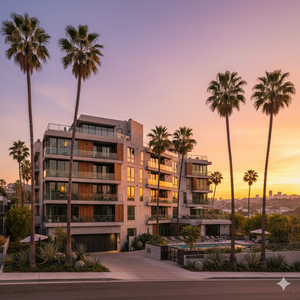Los Angeles Rent Control Laws vs. California AB 1482: Complete Guide for Property Owners
Understanding rent control regulations in Los Angeles can be complex for property owners and landlords. Los Angeles operates under its own strict rent control system called the Rent Stabilization Ordinance (RSO), while California's statewide Tenant Protection Act (AB 1482) provides additional protections for properties not covered by local ordinances. This comprehensive guide explains how these overlapping laws affect your rental property investment and tenant relationships.
Los Angeles Rent Stabilization Ordinance (RSO): Local Rent Control Rules
The Los Angeles Rent Stabilization Ordinance is one of the most restrictive rent control laws in California, affecting thousands of rental properties throughout the city.
RSO Coverage and Property Requirements
The RSO applies specifically to rental units constructed on or before October 1, 1978. This cutoff date means that older apartment buildings, duplexes, and multi-family properties built during Los Angeles' housing boom of the 1960s and 1970s fall under these strict regulations.
Current RSO Rent Increase Limits
For the period from July 2025 through June 2026, RSO-covered properties face highly restrictive rent increase caps:
3% maximum annual rent increase for most properties
4% maximum if the landlord pays for tenant gas or electricity utilities
These increases are significantly lower than market-rate adjustments, making RSO properties particularly challenging for investors seeking rental income growth
RSO Eviction Protections and Just Cause Requirements
Los Angeles RSO provides comprehensive tenant protections beyond rent caps:
Just cause eviction requirements for all tenant removals
Relocation assistance payments required for no-fault evictions
Specific procedural requirements that landlords must follow before evicting tenants
Ellis Act protections for tenants in buildings being removed from rental market
California AB 1482: Statewide Tenant Protection Act
California's AB 1482, enacted as part of the statewide Tenant Protection Act, creates baseline rent control and eviction protections for properties not covered by stricter local ordinances.
AB 1482 Property Coverage
AB 1482 applies to most rental properties built before January 1, 2005 that aren't already subject to more restrictive local rent control laws. This broader date range covers significantly more properties than Los Angeles RSO, including newer apartment complexes, condominiums, and single-family rental homes built in the 1980s, 1990s, and early 2000s.
Statewide Rent Increase Calculations Under AB 1482
The statewide rent cap formula under AB 1482 allows higher increases than Los Angeles RSO:
5% plus Consumer Price Index (CPI) annually
Maximum 10% total increase per year, regardless of CPI
CPI calculations based on regional inflation data, providing some market responsiveness
AB 1482 Eviction Protections and Just Cause Requirements
Similar to Los Angeles' Just Cause Ordinance (JCO), AB 1482 provides:
Statewide just cause eviction protections
Required notice periods for different eviction types
Tenant relocation assistance requirements for specific no-fault evictions
Protection against retaliatory evictions
Important AB 1482 Exemptions for Single-Family Properties
AB 1482 includes significant exemptions that don't exist under Los Angeles RSO:
Single-family homes and condominiums owned by individuals (not corporations, LLCs, or REITs)
Written exemption notice requirement: Tenants must receive written notice of exemption
Corporate ownership disqualifies exemption: Properties owned by business entities remain covered
Which Rent Control Law Applies to Your Los Angeles Property?
Understanding which regulation governs your specific property requires careful analysis of construction dates, property types, and ownership structures.
RSO Takes Precedence Over AB 1482
When Los Angeles properties qualify for RSO coverage, RSO rules completely override AB 1482 because local ordinances provide stricter tenant protections. This means RSO-covered properties cannot benefit from AB 1482's higher rent increase allowances or exemptions.
Properties Subject to AB 1482 Only
Los Angeles rental properties built after October 1, 1978, but before January 1, 2005 typically fall under AB 1482 rather than RSO. These properties include:
Apartment complexes built during the 1980s and 1990s housing expansion
Converted condominiums and townhomes
New construction rental properties completed before 2005
Properties Potentially Exempt from Both Laws
Certain Los Angeles rental properties may qualify for complete exemption from both RSO and AB 1482:
Single-family homes owned by individuals with proper exemption notices
Condominiums owned by individuals with proper exemption notices
New construction completed after January 1, 2005
Properties qualifying for other specific statutory exemptions
Real-World Examples: How These Laws Affect Los Angeles Landlords
Example 1: Pre-1978 Apartment Building (RSO-Covered)
A 20-unit apartment building constructed in 1975 in Mid-City Los Angeles falls under RSO jurisdiction. The owner can only increase rents by 3% annually (or 4% if paying utilities), must provide just cause for evictions, and cannot claim AB 1482 exemptions regardless of ownership structure.
Example 2: 1985 Apartment Complex (AB 1482-Covered)
An apartment building completed in 1985 in Hollywood doesn't qualify for RSO due to its construction date, but AB 1482 applies. The landlord can increase rents up to 10% annually (5% plus CPI), must provide just cause for evictions, but has more flexibility than RSO properties.
Example 3: Individual-Owned Single-Family Home (Potentially Exempt)
A single-family home purchased by an individual investor and rented out may qualify for complete exemption from both RSO and AB 1482, provided the owner gives proper written notice to tenants. However, if the property is owned through an LLC or corporation, AB 1482 protections apply.
Compliance Strategies for Los Angeles Property Owners
Documentation and Notice Requirements
Property owners must maintain detailed records demonstrating compliance with applicable rent control laws:
Annual rent increase calculations and justifications
Proper tenant notifications for rent increases
Just cause documentation for any eviction proceedings
Exemption notices for properties claiming AB 1482 exemptions
Professional Property Management Considerations
Given the complexity of overlapping Los Angeles and California rent control laws, many property owners benefit from professional property management services that specialize in regulatory compliance, tenant relations, and legal requirements specific to Los Angeles rental markets.
Investment Strategy Implications
Understanding which rent control laws apply to specific properties significantly impacts investment decisions, cash flow projections, and long-term property value assessments in the Los Angeles real estate market.
Frequently Asked Questions About LA Rent Control vs. AB 1482
Can I convert my RSO property to escape rent control? Generally no - RSO properties remain covered even after ownership changes, and conversion options like Ellis Act withdrawals have strict requirements and costs.
How do I determine my property's exact construction date? Check Los Angeles County Assessor records, building permits, or certificate of occupancy documents to verify construction completion dates.
What happens if I don't provide required exemption notices? Properties that should be exempt from AB 1482 will remain covered by the law if proper written notices aren't provided to tenants.
Need help determining which rent control laws apply to your Los Angeles property? The Borges Real Estate Team specializes in helping Los Angeles property owners navigate complex rent control regulations and maximize their investment returns. Get an instant property value assessment and regulatory analysis at: https://justin.lametrohomefinder.com/seller











![Your Home Buyer Wants To Extend The Closing Date—What Now? [PART 1]](https://images.squarespace-cdn.com/content/v1/5c34fbe65b409bfee398fd05/1763491903766-XY3PGEQE8677MS334CL0/banner.jpg?format=200w)


